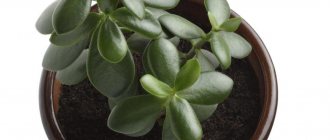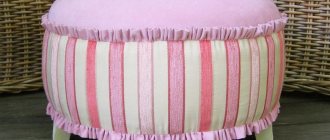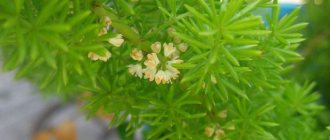The demand for cacti as decorative flowers is constantly growing. They are inexpensive, do not require complex care, are resistant to diseases and pests and take up little space, so they are suitable for any apartment or area. Flower growers planning to work with them should find out the characteristics of the cactus species of interest and determine the varieties of plants already purchased. This will help you choose the right watering and fertilizing scheme for each variety.
Types of home cacti
There are several thousand species of cacti. Let's talk about the most common and popular of them.
Aztecium
Aztekium has a single spherical stem, reaching 10 cm in height and 20 cm in diameter. The plant has from ten to fifteen sharp and clearly defined ribs. Along each rib there are areoles with small spines.
It blooms during the day, the color of the flower is purple, the diameter is about three centimeters in diameter. The plant blooms from the beginning of July to the end of August. In place of the flower, a fruit with brown or black seeds is formed.
Aztecium during flowering Source kaktus-world.ru
Gymnocalycium
Gymnocalycium Saljo has a spherical stem that reaches 35 cm in diameter. Curved spines can reach 4.5 cm. It has beautiful pink or white flowers.
Blooming gymnocalycium Source botsad.ru
Cereus
These cacti have a second name - wax candle, and in natural conditions they grow 4 times taller than a person. Several compact varieties of this cactus are grown at home.
Variety of Cereus Source old.botaniccraft.ru
Under natural conditions, cereus live up to 300 years. In an apartment or private house, this plant will live for a long time and can reach a meter in height.
Cereuses amaze with their beauty Source klumba.guru
Very often this plant is used as a rootstock for more demanding varieties of cacti.
Cereus is the ideal rootstock Source www.asergeev.com
Cephalocereus
This plant is distinguished by a dense stem, which is covered not only with thorns, but also with thick hairs, reminiscent of gray hair or a beard. Its unpretentiousness and exotic appearance make this variety very popular among gardeners.
Cephalocereus are found in deserts, grow very slowly and live long. But it is almost impossible to get these cacti to bloom at home.
Cephalocereus in the winter garden Source roza-i-fialka.ru
Oreocereus
This genus has only six species. The plants have straight, columnar-shaped stems, which in natural conditions can reach a meter in height. In addition to hard spines, the cactus has many dense hairs that completely cover the body of the plant. Flowers can have various shades of red.
Oreocereus in natural conditions Source mandarin-shop.ru
Cactus parody
This genus includes more than 50 species. Most of them are found wild in Bolivia, Argentina, Uruguay, and Mexico. Their stem has a spherical shape. On clearly defined ribs there are a large number of tubercles with fluffy areolas. Plants of this group adapt well at home and begin to produce flower stalks at a young age. After flowering, fruits form on the plant.
These cacti need sandy or rocky soil and good sunlight. If desired, you can achieve flowering from them even at home.
The Golden Barrel has the popular name “Mother-in-law’s Pillow”. Habitat: Mexico. In nature, its diameter reaches one meter, but at home its dimensions are more modest. If the growing conditions for the plant are comfortable, then the cactus does not bush and does not produce children.
Pillow for mother-in-law Source img.tourister.ru
Schlumberger or Zygocactus
Such cacti are also called Decembrists or Christmas cacti due to the fact that mass flowering of these plants begins at the end of December. A large number of names of one plant species indicates its wide distribution.
Such cacti grow quickly, do not have thorns, attract with their appearance even between flowering periods, and do not require special care. At the beginning of winter, the plants are strewn with bright large flowers.
Today, breeders have developed a large number of varieties of this plant, with a wide variety of colors and leaf shapes. This makes it possible to collect a whole collection of Christmas items.
Ideal home decoration Source s1.1zoom.ru
A wonderful specimen for the collection Source indoor-plants.net
Forest cacti
This variety of plants has adapted to living conditions in tropical forests. They prefer to lead an epiphytic lifestyle, and the spines of these cacti have turned into dense, leathery leaves. Some types of such plants can be successfully grown at home. They need high humidity levels and long daylight hours.
This plant prefers diffused light Source klumba.guru
Mammillaria
This group includes plants with a high level of adaptation to various conditions. Such cacti have a cylindrical or round shape, and small papillae or tubercles instead of the usual ribs, which are placed in a strict order and form spiral rows.
Also, most mammillaria have light filaments that resemble a light cobweb. This variety of cacti is not only guaranteed to bloom, but also produces bright red fruits that decorate the plant for a long time. There are representatives of mammillaria that have large and beautiful flowers, but there are also those that bloom with small, inconspicuous flowers.
Despite the small size of the buds, the plant will not leave anyone indifferent Source avatars.mds.yandex.net
A large number of species allows you to create your own collection Source promogaz.ru
Prickly pear
There are almost 200 species in this genus of cacti. Prickly pears are distributed throughout the world. A characteristic feature of this genus is considered to be flat leaves, reminiscent of cakes, covered with sharp spines. Prickly pears have beautiful flowers with a pleasant aroma, and the fruits that appear at the flowering site are not just edible, but have an original, pleasant taste.
Prickly pear fruits are quite edible Source naturalabode10.ru
You can make homemade preparations from the fruits Source t-9design.ru
Prickly pear berries contain vitamin C, and the tissues contain a lot of potassium and calcium. The succulent is used to treat stomach pain, hypertension, ulcers, obesity, fight cholesterol and restore blood sugar levels.
Soap and vitamins are also successfully produced from the plant.
Hathiora solyanka
Such plants are a little reminiscent of the Decembrists. They have long branches and shoots that form a kind of mop. These cacti can be used for growing in hanging pots. Hatiora is easy to care for, but its shoots are fragile, which can be difficult to care for.
An excellent option for creating unique compositions Source komnatnie-rastenija.ru
Aporocactus
These cacti are native to the forests of Central and Southern Mexico. Plants can live in the soil or grow on trees like epiphytes. However, they do not feed on the vital juices of the plant on which they live. A characteristic feature of aporocacti are long cylindrical shoots, very densely covered with spines.
Such plants can normally exist at a temperature of 6-8 degrees, and even at a lower temperature for a short period of time. Flower buds of the plant form in winter. For the largest number of them, the cactus pot should be placed in the most illuminated place. In summer, the plant should be shaded a little.
Harsh sunlight can cause sunburn or yellowing of shoots. As a result, the cactus will lose its attractive appearance. In order to avoid damage to the succulent by spider mites, it is worth periodically taking the pot with the plant out into the open air.
Aporocactus prefers diffused lighting Source semeika.info
See also: Catalog of projects for gazebos made of laminated veneer lumber and aerated concrete blocks.
Lophophora
These plants have another name - peyote. Such a beautiful and practically thornless cactus is considered one of the most sought after. The fleshy stem contains a hallucinogenic substance, which was the reason for the ban on the cultivation of these cacti in Russia since 2004. But if you correctly formalize an official commitment to sell or transfer plants to others, you can obtain permission to grow this variety of cacti.
Lophophora blooms profusely throughout the summer, and red fruits form in place of the flowers.
Lophophora attracts with its unusual appearance Source i2.wp.com
Astrophytums
These are plants with large curved spines, a small number of ribs and felt patches on the surface of the stem. They can be grown on south-facing windows where it is warm and receives sufficient sunlight. In winter, these succulents should be kept at a temperature of about 8 degrees. These cacti have very large seeds that can be successfully sown and seedlings obtained.
The variety of species allows you to collect collections Source rosemary.moscow
Astrophytums bloom and produce seeds from which new plants can be grown Source cdn.kadin.com
Cleistocactus
This succulent has tall, columnar stems densely covered with needles. Sometimes there are so many spines that they resemble animal fur. Under natural conditions, the height of the stem reaches 4 m.
The root system is branched and very powerful, which allows the plant to extract nutrients from the deep layers of the soil. At home, some varieties of the plant can reach 4 m, but most grow no higher than 40 cm. The genus of Cleistocactus has more than 50 species.
Cleistocactus can be part of the composition in the winter garden Source fb.ru
The bristly spines can be red, yellow, white, or gray. A plant that has reached maturity can produce a large number of buds that bloom at one time. The flowering period can last from mid-spring to late summer. In place of faded buds, bright oblong fruits are formed, which give the succulent a beautiful appearance.
Cleistocactus emerald is distinguished by sparse and dense needles, as well as bright pink flowers with emerald-colored edges.
Blooming emerald cleistocactus Source kibersport.net
The most expensive and widespread species is Strauss's cleistocactus. Its stem is covered with light silvery needles and can grow up to 4 m in height. This type is suitable for decorating a winter garden.
The flowering of Strauss's cleistocactus is amazing Source cvetyportal.ru
Cleistocactus Wintera has stems that spread along the ground. The plant does not grow higher than 1 meter. The surface of the stems is covered with thin yellow bristles. The flowers are pinkish, with an orange center.
An interesting option for a composition in a winter garden Source promogaz.ru
Video description
In this video, watch the 10 most beautiful cacti for home cultivation:
See also: Catalog of companies that specialize in garden houses and landscape design.
Rhipsalis
Soft woody succulents come from the rainforests of Brazil. They have a large number of stems that hang down in cascades. These cacti grow very quickly, and with proper care you can get a beautiful and voluminous indoor plant in a few years. The rhipsalis genus has more than 60 species, and a very small number of species can be grown at home.
Rhipsalis Barchela has thin cylindrical shoots.
This type of cactus will perfectly complement any composition in the house Source klumba.guru
Rhipsalis hairy is distinguished by thin and long shoots that not only branch, but also twist a little. At the end of autumn, the shoots are covered with small white flowers.
Really resembles hair Source prorostet.ru
Rhipsalis elliptical is a bit like a Christmas tree, but its buds form along the edges of the leaf blades. Flowers painted light yellow.
It should not be confused with the Christmas tree Source worldofsucculents.com
Rhipsalis pilocarpa is distinguished by powerful shoots of a dark green hue, covered with long hairs. Buds form on the shoots several times a year. The flower is white with a slight yellowish tint and has a large number of stamens.
Wonderful home decoration Source i.ytimg.com
Multicolored cacti
Cacti are plants that are susceptible to mutations. Sometimes shoots grow from seeds that do not have chloroplasts - cellular organelles containing chlorophyll.
As a result, the plant not only has an orange, pink or yellow color, but also cannot survive on its own, since it is not able to produce the necessary substances when exposed to sunlight.
In other words, the process of photosynthesis is impossible for such specimens. But, if such a plant is grafted, the rootstock will feed such a plant. For the first time, such experiments began to be carried out in Japan, which is why such cacti are sometimes called Japanese.
Under natural conditions, these cacti die Source i1.wp.com
Almost all types of cacti have seedlings with a mutation without chlorophyll. But the most widespread species are those that grow quickly and have a tendency to reproduce vegetatively, that is, they form many additional children.
The most unpretentious varieties are used for the rootstock Source flowers.evroopt.by
For such plants there is no need to create special conditions - the main thing is that the rootstock is alive. They can be successfully used to decorate any interior or create various compositions.
Each composition is unique Source krrot.net
Mammillaria
Thanks to its simple care, this species is very popular and loved by gardeners. The plant is covered with soft and long needles similar to hairs. Mammillaria has about 500 species. They differ from each other in the structure of the stem: cylindrical, spherical.
Mammillaria
Mammillaria
Mammillaria differs from other representatives of the Cactus family by the presence of a large number of papillae on the stem. Flowers of red, purple , and snow-white shades appear from the axils between the papillae.
Mammillaria
Mammillaria
Mammillaria
Features of growing cacti at home
Cacti in the wild are found primarily in deserts and are able to survive in extreme conditions. They tolerate drought, temperature changes, and bright sunlight well. All cacti can be classified as succulent plants. Cacti are able to accumulate liquid in their tissues and use it when a dry period occurs.
Such plants successfully survive in conditions of temperature changes up to 40 degrees, lack of moisture and infertile sandy or rocky soil.
Cactus in the wild Source mandarin-shop.ru
Most varieties of cacti have long been cultivated, and there are a large number of hybrids that are not adapted to life in nature. Decorative cacti can be combined into various compositions.
Even an inexperienced gardener can achieve active growth and lush flowering, since cacti do not need to be regularly watered, pruned, replanted or sprayed. At the same time, do not forget about protection when working with succulents. To do this, you need to use gloves or wrap the stem with old newspapers.
You won’t be able to pick up this succulent without protection Source autogear.ru
It is also worth taking into account that the most beautiful cacti for the home are quite expensive. To create a composition, you can use different types of plants, and mature and expensive specimens should be used as the center of the composition or as a single plant.
Absolutely all types of cacti bloom in natural conditions. But on the windowsill or in the winter garden, flower buds are produced mainly by the following species: Cereus, Chamecereus, Mammillaria, Frailea, Echinopsis, Epiphyllum, Rebutia, Phyllocactus, Wiloxia, Astrophytum, Zygogcactus. It is much easier to create favorable conditions for these types of plants. It is also worth remembering that some types of succulents emit a rotten meat aroma when flowering. This is especially true for forest cacti.
Many succulents delight not only with their beautiful appearance, but also with their abundant flowering Source pro2-bar-s3-cdn-cf1.myportfolio.com
Parody is the muse of poets
A plant with an unusual name grows in South America. There are many types of this succulent. Their names are poetically beautiful: Zolotistoklyuchkovaya, Goldenneedle, Snowy, Majestic... You can write dozens of songs, ballads and poems about them.
Taking care of it is not that difficult. The cactus needs to be watered regularly. Flowers without thorns do not tolerate direct sunlight. But the sun will not harm their prickly brothers.
Video description
In this video you will see how to care for cacti so that they bloom:
How to properly organize lighting
Most cacti prefer bright sunlight. But you shouldn’t change the radiation intensity suddenly. To prevent the stem from getting burned, it should be shaded during the first weeks on a sunny windowsill. For this, white non-woven agrofibre or thin translucent paper is used. It should be fixed to the glass and removed after the plant has adapted.
Such succulents do not like bright light Source vsecveti.life
Acanthocalycium - lover of water and soft lighting
These globe-shaped, lemon-spiked desert dwellers bloom from May to September. Their flowers are yellow or white-pink. They need light, but do not expose the cactus to direct sunlight.
The most optimal temperature for keeping the plant is twenty-five degrees Celsius. It must be watered frequently and at the same time ensure that the water does not stagnate. After all, succulents are usually planted in loose soil.
Video description
Watch the video for some more tips on caring for a cactus:
How to choose the right soil
In order for growing cacti to be successful, you need to select a light substrate into which air can easily penetrate. You can purchase ready-made soil mixture for cacti or make it yourself. To do this, you need to mix river sand, turf, and leaf soil. You can put expanded clay, brick chips or gravel at the bottom of the pot. They will serve as drainage.
Plant transplantation
A succulent needs to be replanted if the plant has stopped actively growing and the stem has begun to wrinkle and become dull. For some types of cacti, this procedure needs to be carried out once every two years, for others, once every five years is enough. There is no one rule for everyone; you need to monitor the condition of the succulent.
First of all, you need to protect yourself from injury. To do this, you can use gloves, or wrap the plant with thick cloth, newsprint or a washcloth. There are also special pliers for replanting cacti on sale.
Echinocactus transplant Source pocvetam.ru
The roots need to be carefully shaken out of the pot, cleaned of any remaining old soil, and dead or rotten roots removed. All cuts should be sprinkled with crushed charcoal, and the plant should be left in a dry container for the cuts to heal.
After this, you need to take a larger pot, put a layer of expanded clay on the bottom, sprinkle with a thin ball of soil, and carefully place the cactus. Using a rolled-up newspaper, you need to hold the plant strictly in the center and fill it with soil, making sure that the roots are evenly distributed in the container. Expanded clay or decorative crushed stone can be placed on top of the soil.
Plant after transplantation Source i.ytimg.com
You can water the plant after transplantation only after 15 days. All this time the plant should be in a partially darkened place.
This is how you can decorate the soil surface Source 2.bp.blogspot.com
Ariocarpus - a cactus without thorns
This plant from the cactus family is loved by gardeners for two reasons. The first is the complete absence of thorns. Secondly, its yellowish and lilac petals will attract the attention of even the most fastidious connoisseur. Unfortunately, succulents bloom for only a few days, at the beginning of autumn.
This species requires special soil. The soil is created from river sand, crushed coal and brick chips. The flower needs diffused light. Direct sunlight can destroy this type of cactus.
Briefly about the main thing
Cacti are plants that have adapted to harsh living conditions in deserts. In the process of evolution, the leaves of succulents turned into spines or hairs, and the stems became thicker and learned to accumulate moisture in reserve. Many types of cacti can be successfully grown at home. They decorate the interior of the house with their exotic appearance and beautiful fragrant flowers.
The wide variety of succulent species gives you plenty of choice. There are cacti with and without needles, with different stem shapes - round, columnar, cylindrical, branched. But in order to achieve a beautiful appearance and abundant flowering, it is necessary to provide the plant with the necessary conditions.
Ratings 0
Varieties of cacti
The family includes about 1,750 species, divided into 4 subfamilies. These are perennial plants, characterized by thick stems consisting of special tissues for storing water, and underdeveloped leaves resembling needles.
Cacti differ from each other in size, shape of stems (from spherical to resembling bushes and trees), type of flowers and other characteristics.
Desert and forest
Wild cacti are divided into 2 large groups. They can be desert and forest (tropical). They grow in different conditions, so they differ in external characteristics and internal structure.
The plants are characterized by massive size, long, strong spines, small pale flowers and a short flowering period.
These features help them adapt to harsh external conditions and survive drought, heavy rain, sudden temperature changes, etc.
Home blooming
About half of the existing species of cacti are domestic flowering ones. They differ from their wild relatives in their small size, less developed root system and larger, more beautiful flowers of unusual shapes and shades.
Since the plants were bred specifically for growing in apartments, they have lost their natural ability to adapt and have become more demanding in terms of care and living conditions.











